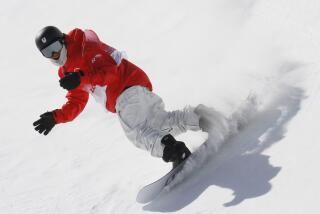Fade to white
- Share via
When the light wanes in late afternoon as the sun dips below mountain ridges, visibility can be fine at the top of a ski or snowboard run. Then, wham, halfway down it’s like somebody turned off the lights.
Overcast skies also can pose a downhill visual challenge, and on days with low, or flat, light, snow and sky often seem to merge. Terrain features become hard to distinguish. Ruts, bumps and icy patches that are easily avoided in bright sunlight fade into the slope. Some skiers and boarders even get dizzy from the lack of visual cues.
Flat light is the No. 1 complaint of professional skiers treated by Dr. Sue Lowe, a skier and optometrist in Laramie, Wyo. “You can’t tell how far away anything is. There are no peripheral clues,” says the chairwoman of the Sports Vision Section of the American Optometric Assn. in St. Louis.
She likens a skier’s vision in flat light to a pilot looking out into the blue sky -- a vast, empty expanse with no boundaries. With an absence of visual clues such as shadows to provide definition, the snow appears as a blank slate, making it difficult to avoid moguls or determine a slope’s pitch.
So what can skiers and boarders do when the lights go out? Try looking at the world through rose-colored glasses. Really.
Wearing goggles to protect your eyes while skiing or boarding is always a good idea. In flat light, the correct color lens becomes important. Yellow, orange and rose are best because they remove components of the light spectrum that increase flatness -- namely blue, said Wade Cleveland, eyewear program manager at Oakley, headquartered in Foothill Ranch. When blue is minimized, the intensity of other colors -- and the contrast -- increases.
For low light, he recommends Oakley’s persimmon, an orange-red lens, which lets 62% of light in, and for the lowest flat light, its “high-intensity” blue lens, which, despite its name, reduces blue and lets 84% of light in.
Liz Randall, a skier and spokeswoman for Smith Sport Optics in Ketchum, Idaho, prefers yellow but says others “swear by rose.”
Most goggle lenses are interchangeable, so goggles can quickly change along with the shifting light. Most of the time, Randall skis with mirrored rose lenses, which she says brighten detail while boosting depth perception. When it begins to snow, she pops in yellow lenses.
Goggles can improve visibility in flat light, but not entirely. Skiers and boarders still need to pick up subtle visual cues and adjust their technique to get a better feel for terrain.
In flat light, the center of a run is like a blank white slate, with no definition, so it’s important to pick out any and all terrain variation and stick to the edges of the run, where even on cloudy days trees cast some shadow, advises Christian Newman, Mammoth Mountain’s sports school supervisor.
More advanced skiers and boarders can duck into the trees, where contrast will be highest -- but only when trees are spaced far enough apart and if you have the skill to avoid them. Staying relaxed with a soft bend in the knees helps prepare for and absorb hard-to-see bumps, Newman says.
One trick that Lowe swears by: Follow the skiers in front of you, making easy S-turns in their paths. Although the ground may be unreadable, the skier should be crystal clear.
The challenge of skiing or riding in flat light forces you to react quickly to changing terrain -- and in the end, should make you more skilled on the slopes.
To e-mail Julie Sheer or read her previous Outdoors Institute columns, go to latimes.com/juliesheer.

